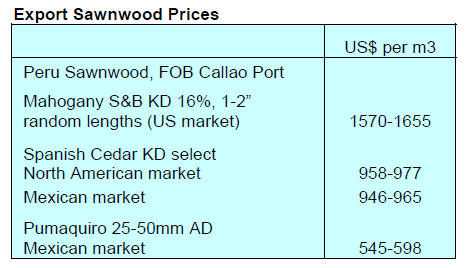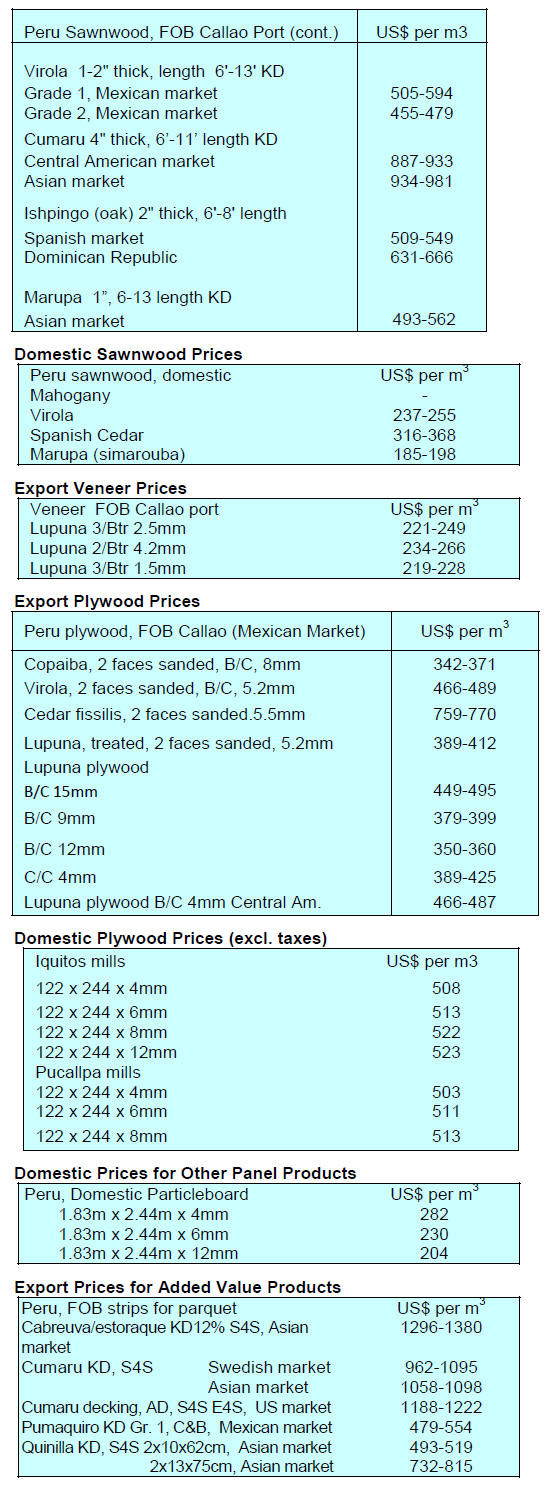2. GHANA
Fight against forest crime takes a new direction
At a National Stakeholders Forum on forest conservation
held recently in Accra, the Forestry Commission indicated
that its fight against illegal logging and other forest crimes
is continuing as the problems are immense and the causes
are complex.
Speaking at the forum, Chris Beeko, Director of the
Timber Validation Department of the Commission said the
Commission plans to introduce a wood procurement
policy to help regulate forest harvesting. In combating
forest crimes, said Beeko, the sector needs to adopt a
multi-faceted approach to address the root causes as well
as the control operations undertaken by the rapid response
teams. Such a multi-faceted approach requires a new
policy direction he said.
Beeko indicated that the Commission aims to form
effective collaboration between civil society organisations,
the national security apparatus and the judiciary to take on
the challenges of securing the forest reserves.
At the Forum representatives from civil society, the
security forces and the judiciary assured the forestry sector
of their readiness to assist in battling forest crime and in
tackling the underlying causes of illegal actions.
Private sector asked to get involved in afforestation
initiatives
Stakeholders at an international workshop in Accra called
for the private sector to participate in the development and
strengthening of afforestation initiatives as this could lead
to a revitalisation of the sector.
The workshop focused on forestry developments in
response to climate change and trans-boundary forestry
issues. Contributing to the workshop, the Executive
Secretary of the African Forests Forum, Professor Godwin
Koweri, said “Africa stand a greater chance of profiting
from tree plantation programme if private participation is
encouraged, well-developed and strengthened.”
Experience in Ghana and elsewhere has shown that
sustainable livelihoods is best achieved when there is a
private-public partnership development approach as this
strengthens private sector involvement in addressing social
inequalities.
AGI welcomes China loan
In a press release, James Asare-Adjei, president of the
Association of Ghana Industries (AGI), welcomed the
Ghana government engagement with China to secure a
US$15 billion loan for its economic development drive.
The AGI president was a member of a delegation that
recently travel to China to promote trade and investment.
Asare-Adjei commented that Ghana needs to advance
industrialisation at a faster pace and he applauded the
vision of the government in trying to rebuild a solid
industrial base in Ghana.
The press release points out that many companies in
Ghana have collapsed due to unfavourable policies of the
previous which led to high operating costs, burdensome
interest rates, currency depreciation and power shortages.

3.
SOUTH AFRICA
Business confidence still very low
There is still little or no evidence of the proposed
government infrastructure spending and reports show that
state owned enterprises are borrowing at an alarming rate
which is constraining the government’s plan for its
R800bn infrastructure programme.
One of the major aluminium producers in S. Africa
has
said local demand for window, door and ceiling extrusions
is very low and customers are only ordering what they
need for immediate use.
Massmart, one of the biggest retailers in S. Africa has a
building division (Massbuild) which as reported zero sales
growth this year.
Building in the Cape Town area has been affected by the
drought as builders do not have enough water, several
builders have halted construction multi-unit projects
entirely until they can get enough water .
Unemployment crisis - solved only when economy
picks up
The Reserve Bank lowered the prime rate by 0.25% in mid
July and is forecasting just 0.5% growth for this year.
Unfortunately this means the country will not be able to
tackle the unemployment crisis.
The most recent OECD report on South Africa says the
unemployment rate was at a 14-year high of almost 28%
in the first quarter of 2017. The report continues, “growth
has to be driven higher in order to absorb all the young
men and women who are seeking opportunities.”
Importers face tough times
Importers are having a tough time not only because of the
local demand but also because the Rand has been very
volatile in the past few weeks, it has been as weak as
R13.50=US$1 and is currently trading at R12.90=US$1
which makes purchasing decisions very tricky.
There have been some reports of retailers getting new
business since the interest rate drop but there are no signs
of improvement in the residential building market which
remains depressed.
The anticipated shopfitting renovations as some stores in
the malls have changed hands has not materialised as the
new tenants are delaying committing to the rents.
Market sector round-up
The decking market is steady but there is no strong
demand and some customers are preferring local
eucalyptus and pine rather than imported species.
Domestic pine mills are still building up stock levels there
have been instances of price discounting. In the current
market the plan to raise prices has been postponed.
The American hardwood market has been reasonably
steady with most of the demand being for white oak with
some demand also for ash.
There has been some movement of European beech and
douglas fir but the strong Euro is holding back sales.
The board market is under pressure. PG Bison
(manufacturer of wood-based panel products founded in
1987 and based in Sandton, South Africa) has
commissioned their new plant which has added 13,000
sq.m per day to their overall production. They have also
installed a high gloss line.
The market for African species is also patchy, mainly due
to erratic delivery problems. There have been reports of
Zambian authorities halting the export of logs brought into
the country from DRC for onward shipment to mainly
China. The problem appears to be that Zambia does not
allow log exports and the process for transshipment is not
clear. Analysts write it is there could be as much as 45,000
cu.m held up in Zambia.
4.
MALAYSIA
Timber import regulations enter
into force
The MTIB website has reminded Malaysian importers of
timber that implementation of the timber import legality
regulations under the Timber Legality Assurance System
came into effect on 1 July 2017.
Applications for import licenses for logs, baulks,
sawntimber, plywood, veneered panels and similar
laminated wood (HS 4403, 4407 and 4412) from MTIB
must be accompanied by evidence of legality from the
supplier.
It is compulsory for all importers to submit: (i) CITES
Permit / Certificate (if products are under CITES lists),
and (ii) Copy of the Certificate of Origin, including any
one of the following to verify legality:
 FLEGT licenses
FLEGT licenses
 Certificate issued by a recognised
timber
Certificate issued by a recognised
timber
certification body
 Certificate of Voluntary Legality Scheme
Certificate of Voluntary Legality Scheme
 Legality document issued by recognized
Agency /
Legality document issued by recognized
Agency /
Corporation / Association
 Self-declaration documents by the
exporter with
Self-declaration documents by the
exporter with
endorsement by the authorities of the exporting
country
 Copy of the Customs Export Declaration
from
Copy of the Customs Export Declaration
from
exporting countries
For the full details see:
http://www.mtib.gov.my/index.php?option=com_content&view=
article&id=2418%3Aimport-legality-regulation-under-timberlegality-
assurance-system-tlas-&catid=1%3Ahighlights&lang=en
Challenges remain in expanding furniture exports
In a statement to the press, Chua Chun Chai, Malaysian
Furniture Council (MFC) president said furniture exports
will expand faster this year and much of the expansion
will be due to the ban on sawn rubberwood export. Chua
expects furniture exports to top RM10 billion this year, up
about 4% from 2016.
If this can be achieved then the sector is well advanced
towards the RM 16 billion target in the Malaysian Timber
Industry Board’s (MTIB) National Timber Industry Policy
projections for the period 2009-2020.
Between January and April this year exports grew 6%
largely on the back of firm demand in the US market.
While the US market is number one for Malaysia’s
furniture, Chua pointed out demand in Australia, Japan,
Singapore, the UK and Middle East is firm. In addition
there has been success in the Indian market, a focus of
attention for the MTIB in recent months.
Despite the good prospects there are challenges, said
Chua, one of which is the shortage of labour which is
holding back growth in the furniture sector.
At issue is the ratio of foreign workers to local workers set
by the government. At present the highest ratio permiited
by government is 3:1 but if this can be lifted to 5:1 then
faster growth can be achieved said Chua.
The other challenge is to encourage companies to move to
greater levels of automation said the MFC president.
Despite the rising costs of doing business in Malaysia
Chua said the furniture sector has a bright future if the
challenges can be addressed with manufacturer friendly
policies.
STA research funding
The Sarawak Timber Association (STA) will invest RM
2.4 million to fund a two year research project on
‘Development and Deployment of Improved Genetic
Materials of Falcataria Moluccana’ (Moluccan albizia).
The STA has been providing funds to universities,
research-based companies and other research agencies
since 2005.
STA Chairman, Wong Kie Yik, said that the latest projects
funded by the association include RM400,000 to
Universiti Malaysia Sarawak for a three-year research on
the production of high quality kelampayan species
(Neolamarckia cadamba) for forest plantations.
Wong added that the STA is currently providing over
RM580,000 to Swinburne University of Technology,
Sarawak Campus, for a project aimed at identifying and
isolating the rhizosphere microorganism in the soil which
could be harnessed to raise plantation productivity.
Export round up
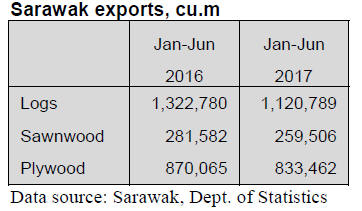
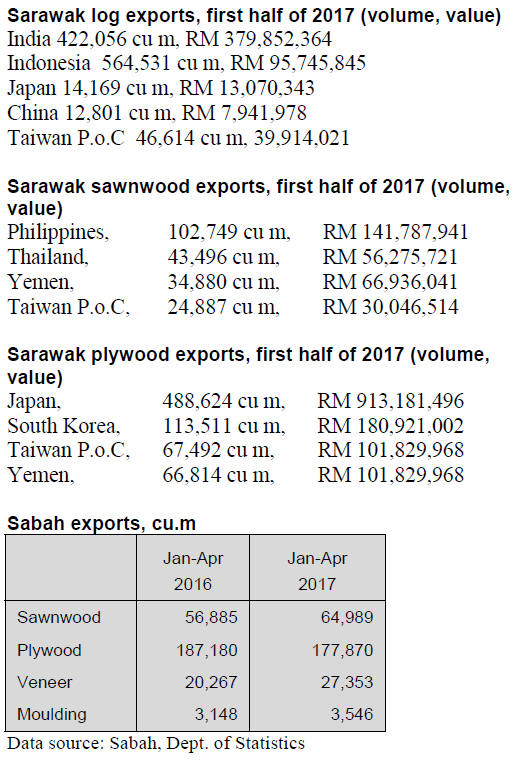
Exports and domestic consumption boosts growth
The International Monetary Fund has upgraded its 2017
growth forecast for Malaysia to 4.8% from 4.5%.
In the first quarter of 2017, Malaysia’s economy grew at a
better-than-expected 5.6% annual rate – the quickest pace
in two years – on robust exports and strong domestic
demand.
The ringgit has also recovered, from being among the
weakest emerging Asian currencies in 2016, following
measures by the central bank.

5. INDONESIA
Delivering benefits of FLEGT to SMEs
A national policy dialogue co-hosted by the Center for
International Forestry Research (CIFOR) and the Ministry
of Environment and Forestry brought together more than
200 policy makers, scientists, business owners, craftsmen
and more to discuss how to deliver the benefits of the
FLEGT license scheme to small and medium enterprises.
Putera Parthama, Director General for Sustainable Forest
Management from the Ministry of Environment and
Forestry, said the FLEGT license will serve to improve
competitiveness, a view shared by Charles-Michel Geurts,
Deputy Head of the European Union Delegation in
Indonesia.
Geurts provided figures on Indonesia’s timber exports to
the EU which have grown significantly. He praised the
success of Indonesian companies in taking advantage of
the FLEGT licenses to expand trade with the EU.
See: http://www.cifor.org/press-releases/eu-timber-license-couldhelp-
indonesian-small-scale-furniture-exporters-access-globalmarkets/
Danish importers raise FLEGT documentation issues
Indonesia’s Ambassador in Copenhagen, Muhammad Ibnu
Said, has reported that Danish importers are facing a
problem because of details on the various FLEGT
documents. He said companies in Denmark have found the
product weight stated in the various Indonesian import
documents do not always correspond.
Despite this issue the Ambassador reported that Danish
importers are happy to see FLEGT licensed wood products
and that there are opportunities for market growth in
Denmark.
Drive down costs of accessories and finishes to boost
competiveness
The Ministry of Industry is aiming to consolidate the
structure of the furniture industry and to drive down the
cost of raw material inputs in furniture making so as to
boost competiveness.
Panggah Susanto, Director General of Agroindustry in the
Ministry of Industry, is aiming to streamline and reduce
the cost of imported accessories for the furniture sector.
Recently the Indonesian Furniture and Handicraft
Association announced a strategy to improve the
competitiveness of the furniture industry. Included was the
need to lower the costs of all raw materials used by
manufacturers, especially the cost of accessories and
finishes.
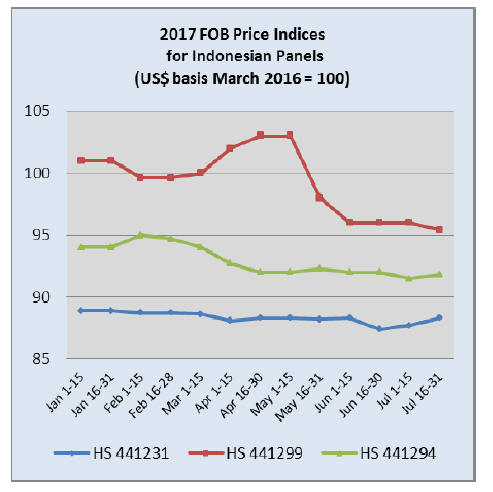
6. MYANMAR
MTE confirms - Private sector to be
contracted for
logging
The Deputy General Manager of the Extraction
Department in the Myanmar Timber Enterprise (MTE) has
reaffirmed that the private sector will be contracted to
undertake log harvesting and transport this year. Analysts
report that MTE may rent out its workable heavy
machinery and elephants to contractors.
MTE suspended harvesting and extraction for one year but
will resume in fiscal 2017-18 except Bago Yoma (also
known as Pegu Yoma) a range of low mountains between
the Irrawaddy and the Sittaung Rivers in central Myanmar.
It is understood that that potential contractors will be
required to submit proposals to regional MTE officials
who would decide on contract allocations after consulting
with the MTE HQ.
Almost US$2 billion into Thilawa Special Economic
Zone
Myanmar’s Investment Commission has created a network
between 8 Ministries to provide a ‘one-stop’ information
centre for potential investors. Foreign investment in the
Thilawa Special Economic Zone (SEZ) has grown to
almost US$2 billion in the four years the Zone has been
open. Most investment went into manufacturing followed
by trade, logistics, services and the hospitality sector.
Teak tender sale
On 28 July MTE offered 38.8 HT of grade SG-6 and 685.7
HT of SG-7 ex-site Chin Dwin in Upper Myanmar. prices
secured for SG-6 ranged between US$2,222-2,340 per HT
and between US$1,500-1,736 for SG-6.
7. INDIA
Record low inflation boost hopes for rate
cut
India’s official wholesale price index for all commodities
(Base: 2011-12=100) for June 2017 released by the Office
of the Economic Adviser to the government (OEA)
declined by 0.1% from 112.8 (provisional)in May to
112.7.
The annual rate of inflation, based on monthly WPI, stood
at 0.90% (provisional) for June 2017 compared to 2.17%
for the previous month. Inflation for this financial year so
far was -0.44% compared to a rate of 3.71% in the
corresponding period last year.
The price index for 'Manufactured Wood and of Products
of Wood and Cork ' group declined by 0.1 percent to 130.5
(provisional) from 130.6 (provisional) for the previous
month due to lower price of wooden boards (2%) and
wood cutting, processed/sized, particleboard, wooden
box/crate and timber/wooden sawnwood (1% each).
However, the price of plywood moved up.
The press release can be found at:
http://eaindustry.nic.in/cmonthly.pdf

Andhra Pradesh Forest Development Corporation to
sell red sanders for export
Red Sanders (Pterocarpus santalinus) is a highly valuable
hardwood species that is found exclusively in the Forests
located in Andhra Pradesh State of India. The State
Government of Andhra Pradesh has absolute rights over
the management, possession and sale of red sanders.
Recently the Government of Andhra Pradesh authorised its
corporate subsidiary, Andhra Pradesh Forest Development
Corporation Limited (APFDC), a wholly owned State
Enterprise, to conduct the sale of red sanders stocks held
by the government.
Accordingly, APFDC has announced the sale of over
900
tonnes of graded red sanders logs. The sale will take place
at the Central Warehousing Corporation warehouse in
Renigunta, Chittoor District, Andhra Pradesh. The
government’s Director General of Foreign Trade has
authorised the export of these logs as CITES approved the
sale and export.
Details are available at:
http://www.forests.ap.gov.in/rsv_2017.htm
and
http://www.mstcindia.co.in and I or http://
Surat and Vyara Divisions log auctions
Auctions at various Forest Depots in the Surat and Vyara
Divisions have been concluded. Around 3,300 cubic
metres mostly teak was available.
Other hardwoods sold included Adina cordifolia, Gmelina
arborea, Pterocarpus marsupium, Acacia catechu and
Mitragyna parviflora.
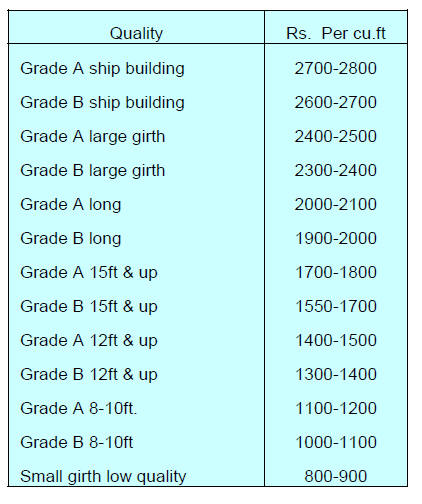
Good quality non-teak hard wood logs also attracted
prices
similar to those in auction at Forest Department Depots in
the North and South Dangs. Top quality non-teak
hardwood logs 3-4m long having girths 91cms & up of
haldu (Adina cordifolia), laurel (Terminalia tomentosa),
kalam (Mitragyna parviflora) and Pterocarpus marsupium
attracted prices in the range of Rs.800-1000per cu.ft.
Medium quality hardwood logs were sold at between
Rs600-700 and low grade logs sold for Rs.300-400 per
cu.ft.
Imported plantation teak prices
Demand for imported logs is steady supported by the
strong Rupee. The application of import duty, GST and
surcharges has pushed prices around 24% higher so
importers are looking for an opportunity to pass on the
higher costs. At the same time, as passing on the higher
prices may not succeed, importers are negotiating with
exporters to secure price discounts.
The Indian trade is trying to get the government to
review
the GST for wood products.
C&F prices remain unchanged but now there is an 18%
GST.
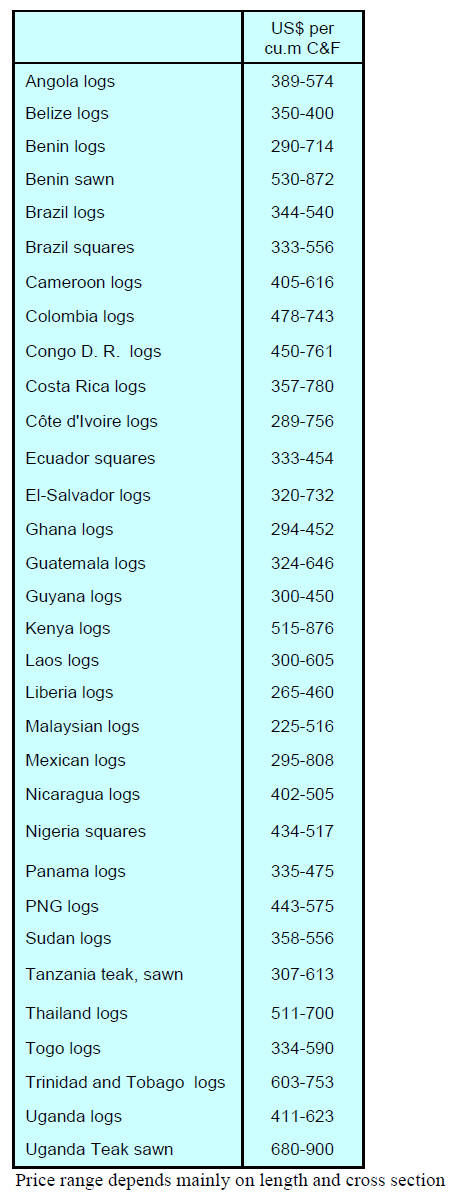
Locally sawn hardwood prices
Prices for hardwoods milled from imported logs are
unchanged.
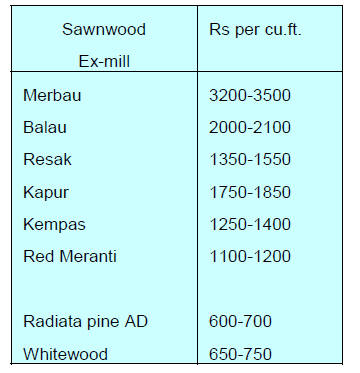
Myanmar teak prices
There were no reports of price movements over the past
two weeks.
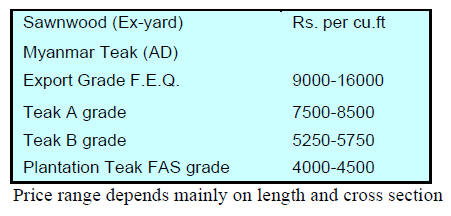
Prices for imported sawnwood
Prices for imported sawnwood (KD 12%) remain
unchanged.
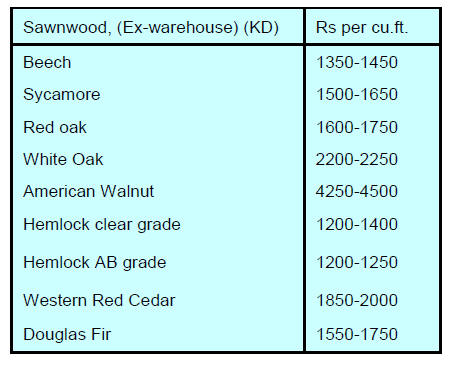
Plywood prices
After adjusting to current tax levels plywood prices have
been raised.

8. BRAZIL
First signs of deflation
For the first time in 11 years the country recorded
deflation of -0.23% in June.
As the economy shows signs of stabilising the Central
Bank Monetary Policy Committee (Copom) felt confident
to again lower the basic interest rate from 11.25% to
10.25% per year.
The World Trade Organization has forecast the Brazilian
economy will gradually recover in 2017 but growth will
continue to be weak. This view was reinforced by an IMF
report that says the international community is of the
opinion that Brazil’s economic woes may be coming to an
end despite the current political turbulence.
Throughout the extended period of recession foreign direct
investment has poured into Brazil. The country received
US$78.93 bil.in FDI during the height of the recession in
2016, the seventh highest global inflow according to the
World Bank.
New transport checks a burden to companies says
CIPEM
The Center for Timber Producers and Exporters of Mato
Grosso State (CIPEM) has raised concerns on the new
requirement for the issuance of the Timber Identification
Certificate (Certificado de Identificação de Madeira -
CIM) by the Mato Grosso State Agriculture and Livestock
Defense Institute (INDEA). These certificates are required
to clear checkpoints during the transport of forest
products.
Under the new rule all trucks carrying wood products have
to divert to a central INDEA check point. CIPEM has
pointed out that this will delay transportation and add to
the cost of delivery.
CIPEM is arguing that prior to transportation the timber
undergoes checks by the State Secretariat for the
Environment (SEMA), the Federal Highway Police (PRF)
and the Brazilian Institute for Environment and Renewable
Natural Resources so the new system is a duplication of
effort and is unnecessary.
This new development Says CIPEM, undermines
competitiveness, disrupts logistics and affects the
profitability of enterprises. CIPEM advocates greater
intensification of inspection throughout the state by
INDEA not additional checks.
Innovation, development and productivity in the
forestry sector
A recent workshop organised by the Paraná State Forest
Based Companies Association and the Brazilian
Agricultural Research Corporation discussed innovation,
development and productivity in the forestry sector. The
main theme was on the "Perspectives and models for
forest industry of the future".
Two approaches were discussed:
First, management for commodity item production
It was determined that success in markets for commodity
products demands high productivity, homogeneity, low
costs, high efficiency and economies of scale.
Second, management for niche market products
In niche markets, diversification, added value, high
efficiency, smaller daily produ
ction and top quality are the
primary requirements.
In order to improve profitability several companies are
being encouraged to combine operations bringing together
forest operations, logistics, residue utilisation and
marketing.
Export update
In June 2017, Brazilian exports of wood-based products
(except pulp and paper) increased 6.2% in value compared
to June 2016, from US$201.5 million to US$213.9
million. The value of June pine sawnwood exports
increased 14.5% year on year from US$29.7 million to
US$34.0 million.
In terms of volume, exports increased 6.8% over the same
period from 156,000 cu.m to 166,600 cu.m.
The volume of tropical sawnwood exports increased 4.7%
in volume, from 32,200 cu.m in June 2016 to 33,700 cu.m
in June 2017, from US$14.6 million to US$15.1 million.
June 2017 pine plywood exports increased 6.3% in value
from US$35.0 million to US$37.2 million. However, in
volume terms exports declined 3.6% (from 134,200 cu.m
to 129,400 cu.m). This signals a sharp drop in average
prices.
On the other hand, tropical plywood, export volumes and
value increased in June 2017 compared to June 2016
(8.2% in volume and 10.8% in value).
On the negative side there was a drop in furniture export
values in June this year. Export values dropped from
US$39.5 million in June 2016 to US$36.9 million in June
2017.
Woodbased panel exports rising
The trade balance in the Brazilian forest plantations sector
reached US$2.9 billion between January and May 2017,
up 4.9% over the same period last year according to the
Brazilian Tree Industry (IBA).
The sector registered total exports of US$3.3 billion, 3.2%
more than in the same period of 2016 with international
sales of woodbased panels totalling US$113 million
(+25.6%).
In 2016, woodbased panel exports topped 91,000 cu.m. In
2017, there was a 25.3% increase pushing exports to
114,000 cu.m.
Latin American markets remain the destinations for
Brazil’s woodbased panels generating revenues of US$62
million in 2017. The second tier market was the US at
US$ 26 million and then Asia, US$16 million.
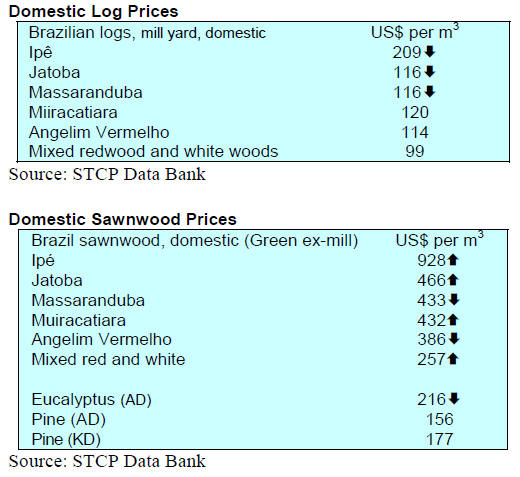
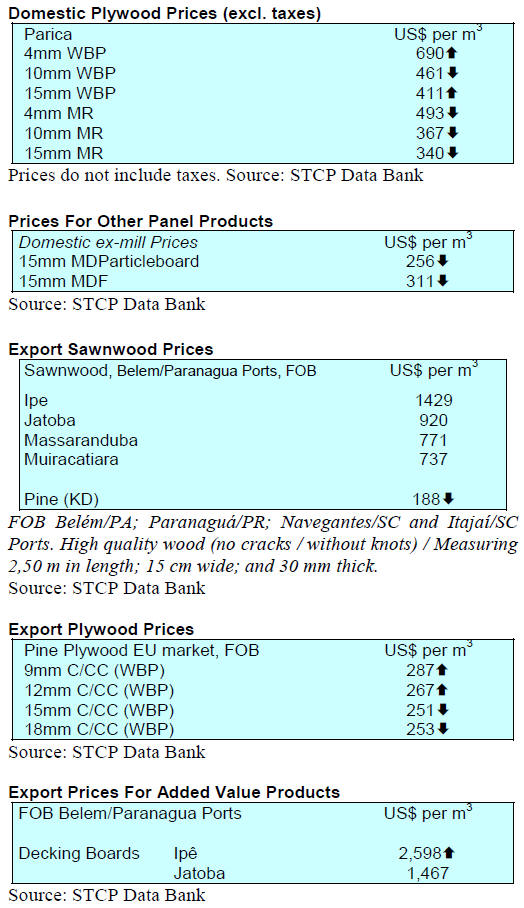
9.
PERU
Peruvian imports of composite boards
Peruvian imports of composite boards in the first half of
2017 remained stable at US$37.07 million, an increase of
0.7% compared to the first half of 2016. The surprise was
the fall of first half shipments from the main supplier,
Ecuador (-17%).
Ecuador, despite the fall, remained the main supplier of
particleboard (PB) to the Peruvian market, with shipments
worth US$14.17 million in the first half of this year.
Imports of PB from Chile, the second ranked supplier rose
slightly (0.7%) to US$12.88 million. Spain was also a
significant supplier in the first half at US$5.14 million and
this was some 23% higher than in the same period in 2016.
In the first half of 2017 shipments from Brazil grew the
fastest and topped US$4.78 million, just over double the
US$2.38 million shipped in the first half of 2016.
Benefits of monitoring forests in the fight
against
deforestation
The National Forest Conservation Program for the
Mitigation of Climate Change (Forest Program) of the
Ministry of the Environment (Minam) and its function in
monitoring deforestation in Peru was recently explained in
the context of the Organization of the Amazon
Cooperation Treaty (ACTO).
Cásar Calmet, the Executive Coordinator of the Minam
Forests Program, explained the Amazon forest monitoring
system developed by the Minam Forests Program provides
regular updates on the forest cover and loss in Peru’s
Amazon rainforests and the information is disseminated
through the Geo-bosques platform.
See (http://geobosques.minam.gob.pe).
Protocol to standardise criteria for timber forest
resources assessment
The National Forestry and Wildlife Service (SERFOR) has
presented a protocol to standardize the criteria for
evaluating forest resources. This details specific technical
procedures for the formulation, approval, inspection,
verification, supervision and control of forest management
plans and is to be applied nationally.
The protocol was elaborated by Serfor, the Forest and
Wildlife Resources Supervision Agency (Osinfor), the
Regional Forest and the Wildlife Authorities of the Loreto,
Madre de Dios and Ucayali regions.
In addition, support was provided by the Faculty of
Forestry Sciences, National University of the Peruvian
Amazon (UNAP) and the Research Institute for the
Peruvian Amazon (IIAP), the National Forest
Confederation of Peru (Conafor Peru). Technical input
was provided by representatives of the Peruvian Forestry
Sector Initiative (PFSI).
